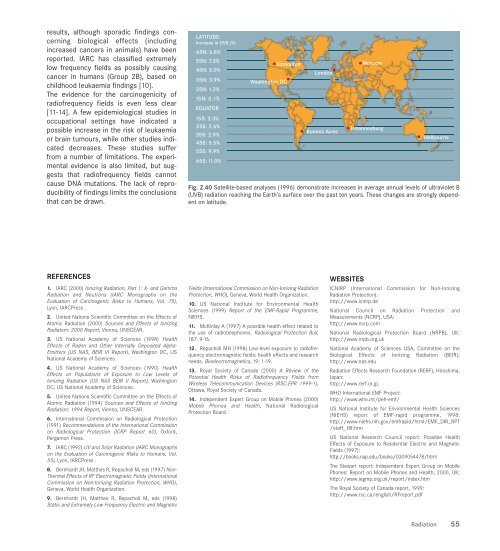world cancer report - iarc
world cancer report - iarc
world cancer report - iarc
You also want an ePaper? Increase the reach of your titles
YUMPU automatically turns print PDFs into web optimized ePapers that Google loves.
esults, although sporadic findings concerning<br />
biological effects (including<br />
increased <strong>cancer</strong>s in animals) have been<br />
<strong>report</strong>ed. IARC has classified extremely<br />
low frequency fields as possibly causing<br />
<strong>cancer</strong> in humans (Group 2B), based on<br />
childhood leukaemia findings [10].<br />
The evidence for the carcinogenicity of<br />
radiofrequency fields is even less clear<br />
[11-14]. A few epidemiological studies in<br />
occupational settings have indicated a<br />
possible increase in the risk of leukaemia<br />
or brain tumours, while other studies indicated<br />
decreases. These studies suffer<br />
from a number of limitations. The experimental<br />
evidence is also limited, but suggests<br />
that radiofrequency fields cannot<br />
cause DNA mutations. The lack of reproducibility<br />
of findings limits the conclusions<br />
that can be drawn.<br />
REFERENCES<br />
1. IARC (2000) Ionizing Radiation, Part 1: X- and Gamma<br />
Radiation and Neutrons (IARC Monographs on the<br />
Evaluation of Carcinogenic Risks to Humans, Vol. 75),<br />
Lyon, IARCPress .<br />
2. United Nations Scientific Committee on the Effects of<br />
Atomic Radiation (2000) Sources and Effects of Ionizing<br />
Radiation: 2000 Report, Vienna, UNSCEAR.<br />
3. US National Academy of Sciences (1998) Health<br />
Effects of Radon and Other Internally Deposited Alpha-<br />
Emitters (US NAS, BEIR VI Report), Washington DC, US<br />
National Academy of Sciences.<br />
4. US National Academy of Sciences (1990) Health<br />
Effects on Populations of Exposure to Low Levels of<br />
Ionizing Radiation (US NAS BEIR V Report), Washington<br />
DC, US National Academy of Sciences.<br />
5. United Nations Scientific Committee on the Effects of<br />
Atomic Radiation (1994) Sources and Effects of Ionizing<br />
Radiation: 1994 Report, Vienna, UNSCEAR.<br />
6. International Commission on Radiological Protection<br />
(1991) Recommendations of the International Commission<br />
on Radiological Protection (ICRP Report 60), Oxford,<br />
Pergamon Press.<br />
7. IARC (1992) UV and Solar Radiation (IARC Monographs<br />
on the Evaluation of Carcinogenic Risks to Humans, Vol.<br />
55), Lyon, IARCPress .<br />
8. Bernhardt JH, Matthes R, Repacholi M, eds (1997) Non-<br />
Thermal Effects of RF Electromagnetic Fields (International<br />
Commission on Non-Ionizing Radiation Protection, WHO),<br />
Geneva, World Health Organization.<br />
9. Bernhardt JH, Matthes R, Repacholi M, eds (1998)<br />
Static and Extremely Low Frequency Electric and Magnetic<br />
LATITUDE:<br />
Increase in UVB (%)<br />
65N: 6.8%<br />
55N: 7.3%<br />
45N: 5.0%<br />
35N: 3.9%<br />
25N: 1.2%<br />
15N: 0.1%<br />
EQUATOR<br />
15S: 2.3%<br />
25S: 2.6%<br />
35S: 2.9%<br />
45S: 5.5%<br />
55S: 9.9%<br />
65S: 11.0%<br />
Washington DC<br />
Edmonton<br />
Fig. 2.40 Satellite-based analyses (1996) demonstrate increases in average annual levels of ultraviolet B<br />
(UVB) radiation reaching the Earth’s surface over the past ten years. These changes are strongly dependent<br />
on latitude.<br />
Fields (International Commission on Non-Ionizing Radiation<br />
Protection, WHO), Geneva, World Health Organization.<br />
10. US National Institute for Environmental Health<br />
Sciences (1999) Report of the EMF-Rapid Programme,<br />
NIEHS.<br />
11. McKinlay A (1997) A possible health effect related to<br />
the use of radiotelephones. Radiological Protection Bull,<br />
187: 9-16.<br />
12. Repacholi MH (1998) Low-level exposure to radiofrequency<br />
electromagnetic fields: health effects and research<br />
needs. Bioelectromagnetics, 19: 1-19.<br />
13. Royal Society of Canada (2000) A Review of the<br />
Potential Health Risks of Radiofrequency Fields from<br />
Wireless Telecommunication Devices (RSC.EPR 1999-1),<br />
Ottawa, Royal Society of Canada.<br />
14. Independent Expert Group on Mobile Phones (2000)<br />
Mobile Phones and Health, National Radiological<br />
Protection Board.<br />
London<br />
Buenos Aires<br />
WEBSITES<br />
Moscow<br />
Johannesburg<br />
ICNIRP (International Commission for Non-Ionizing<br />
Radiation Protection):<br />
http://www.icnirp.de<br />
National Council on Radiation Protection and<br />
Measurements (NCRP), USA:<br />
http://www.ncrp.com<br />
National Radiological Protection Board (NRPB), UK:<br />
http://www.nrpb.org.uk<br />
National Academy of Sciences USA, Committee on the<br />
Biological Effects of Ionizing Radiation (BEIR):<br />
http://www.nas.edu<br />
Radiation Effects Research Foundation (RERF), Hiroshima,<br />
Japan:<br />
http://www.rerf.or.jp.<br />
WHO International EMF Project:<br />
http://www.who.int/peh-emf/<br />
US National Institute for Environmental Health Sciences<br />
(NIEHS) <strong>report</strong> of EMF-rapid programme, 1998:<br />
http://www.niehs.nih.gov/emfrapid/html/EMF_DIR_RPT<br />
/staff_18f.htm<br />
US National Research Council <strong>report</strong>: Possible Health<br />
Effects of Exposure to Residential Electric and Magnetic<br />
Fields (1997):<br />
http://books.nap.edu/books/0309054478/html<br />
The Stewart <strong>report</strong>: Independent Expert Group on Mobile<br />
Phones: Report on Mobile Phones and Health, 2000, UK:<br />
http://www.iegmp.org.uk/<strong>report</strong>/index.htm<br />
The Royal Society of Canada <strong>report</strong>, 1999:<br />
http://www.rsc.ca/english/RF<strong>report</strong>.pdf<br />
Melbourne<br />
Radiation 55

















